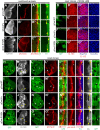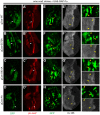Contributions of Costal 2-Fused interactions to Hedgehog signaling in Drosophila
- PMID: 25633354
- PMCID: PMC4352975
- DOI: 10.1242/dev.112904
Contributions of Costal 2-Fused interactions to Hedgehog signaling in Drosophila
Abstract
The Drosophila kinesin-family protein Costal 2 (Cos2) and its mammalian ortholog Kif7 play dual roles in Hedgehog (Hh) signaling. In the absence of Hh, Cos2 and Kif7 contribute to proteolytic processing and silencing of the Hh-regulated transcription factors, Drosophila Cubitus interruptus (Ci) and mammalian Gli proteins. Cos2 and Kif7 are also necessary for full activation of full-length Ci-155 and Gli transcription factors in response to Hh proteins. Here, we use classical fused alleles and transgenic Cos2 products deficient for Fused (Fu) association to show that Cos2 must bind to Fu to support efficient Ci-155 processing. Residual Ci-155 processing in the absence of Cos2-Fu interaction did not require Suppressor of Fused, which has been implicated in processing mammalian Gli proteins. We also provide evidence that Cos2 binding to the CORD domain of Ci-155 contributes to both Ci-155 processing and Ci-155 silencing in the absence of Hh. In the presence of Hh, Ci-155 processing is blocked and Cos2 now promotes activation of Ci-155, which requires Fu kinase activity. Here, we show that normal Ci-155 activation by Hh requires Cos2 binding to Fu, supporting the hypothesis that Cos2 mediates the apposition of Fu molecules suitable for cross-phosphorylation and consequent full activation of Fu kinase. We also find that phosphorylation of Cos2 by Fu at two previously mapped sites, S572 and S931, which is thought to mediate Ci-155 activation, is not required for normal activation of Ci-155 by Hh or by activated Fu.
Keywords: Costal 2 (Cos); Drosophila; Fused; Hedgehog; Signal Transduction.
© 2015. Published by The Company of Biologists Ltd.
Figures







Similar articles
-
Phosphorylation of the atypical kinesin Costal2 by the kinase Fused induces the partial disassembly of the Smoothened-Fused-Costal2-Cubitus interruptus complex in Hedgehog signalling.Development. 2007 Oct;134(20):3677-89. doi: 10.1242/dev.011577. Epub 2007 Sep 19. Development. 2007. PMID: 17881487
-
Regulation of mammalian Gli proteins by Costal 2 and PKA in Drosophila reveals Hedgehog pathway conservation.Development. 2011 Jun;138(12):2533-42. doi: 10.1242/dev.063479. Development. 2011. PMID: 21610030 Free PMC article.
-
Hedgehog-stimulated phosphorylation of the kinesin-related protein Costal2 is mediated by the serine/threonine kinase fused.J Biol Chem. 2002 Jul 5;277(27):24638-47. doi: 10.1074/jbc.M110730200. Epub 2002 Apr 4. J Biol Chem. 2002. PMID: 11934882
-
Regulation of Hedgehog signaling: a complex story.Biochem Pharmacol. 2004 Mar 1;67(5):805-14. doi: 10.1016/j.bcp.2004.01.002. Biochem Pharmacol. 2004. PMID: 15104233 Free PMC article. Review.
-
Mammalian homologues of Drosophila fused kinase.Vitam Horm. 2012;88:91-113. doi: 10.1016/B978-0-12-394622-5.00005-5. Vitam Horm. 2012. PMID: 22391301 Review.
Cited by
-
Yorkie and Hedgehog independently restrict BMP production in escort cells to permit germline differentiation in the Drosophila ovary.Development. 2017 Jul 15;144(14):2584-2594. doi: 10.1242/dev.147702. Epub 2017 Jun 15. Development. 2017. PMID: 28619819 Free PMC article.
-
Hedgehog-stimulated phosphorylation at multiple sites activates Ci by altering Ci-Ci interfaces without full Suppressor of Fused dissociation.PLoS Biol. 2025 Apr 11;23(4):e3003105. doi: 10.1371/journal.pbio.3003105. eCollection 2025 Apr. PLoS Biol. 2025. PMID: 40215228 Free PMC article.
-
Patched and Costal-2 mutations lead to differences in tissue overgrowth autonomy.Fly (Austin). 2022 Dec;16(1):176-189. doi: 10.1080/19336934.2022.2062991. Fly (Austin). 2022. PMID: 35468034 Free PMC article.
-
Drosophila hedgehog can act as a morphogen in the absence of regulated Ci processing.Elife. 2020 Oct 21;9:e61083. doi: 10.7554/eLife.61083. Elife. 2020. PMID: 33084577 Free PMC article.
-
Gli Phosphorylation Code in Hedgehog Signal Transduction.Front Cell Dev Biol. 2022 Jan 25;10:846927. doi: 10.3389/fcell.2022.846927. eCollection 2022. Front Cell Dev Biol. 2022. PMID: 35186941 Free PMC article. Review.
References
Publication types
MeSH terms
Substances
Grants and funding
LinkOut - more resources
Full Text Sources
Other Literature Sources
Molecular Biology Databases

